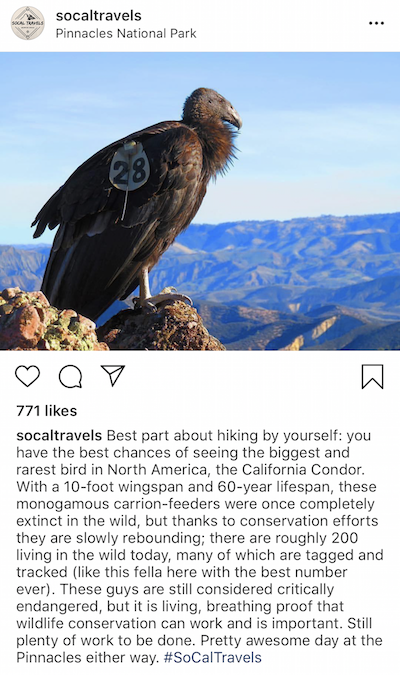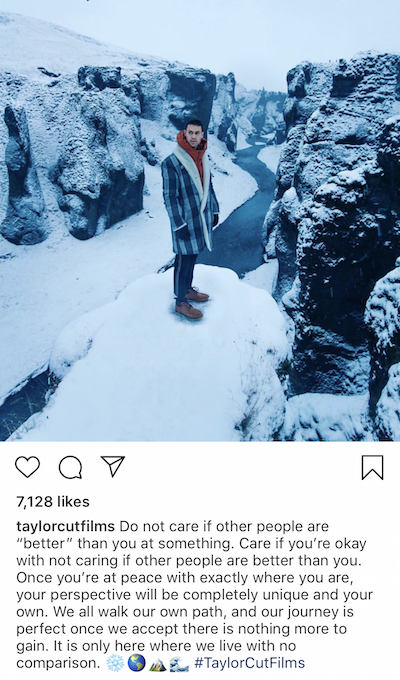How People Interact on Social Media in 2019

How People Interact on Social Media in 2019
Nearly one-third of Americans post, like, or share content on social media more than 10 times every day, and most people prefer to post images. Facebook is still the most popular channel, but people also spend time on other channels such as Instagram and YouTube.
There are more than 2.7 billion social media users around the world – about 35% of the worldwide population – and this number continues to grow each year.
More people use social media than ever before, and that is unlikely to slow down.
The Manifest surveyed 627 social media users to learn how often they access social media, the content they post, and the channels they most frequently use.
As people continue to integrate social media into their everyday lives, it’s important for businesses to reach customers on social media by having a presence on people’s preferred channels and posting their favorite types of content.
Businesses can use this report to learn how people interact on social media and how they can create strategies that appeal to customers’ social media habits, whether in-house or with a social media agency.
Our Findings
- Nearly one-third (30%) of people interact on social media more than 10 times per day by liking, posting, or sharing content.
- Nearly all social media users (94%) post content on social media, and 42% of the people who post content do so at least once per day.
- Images (69%) are the most popular content type that people post on social media, followed by life updates/announcements (47%) and videos (46%).
- More than half of social media users (52%) most frequently access Facebook, but people may be spending more total time on other channels such as YouTube and Instagram.
- Facebook is also the most popular channel for people to both share their own content (52%) and like/share someone else’s content (54%).
- Nearly half of social media users (48%) are more likely to like/share someone else’s content than share their own content (24%).
One-Third of People Interact on Social Media More Than 10 Times Per Day
People tend to interact on social media throughout their day.
Nearly all people (86%) use social media at least once per day, and 30% like, share, or post content on social media more than 10 times per day.

Social media interaction is part of people’s everyday routines.
“Social media has become ingrained in our day-to-day lives,” said Charlotte Chipperfield, founder and CEO of Chipperfield Media, a storytelling social media agency in Portland, Ore. “We use it for more than just sharing personal updates. It’s a way of building a community around our shared interests and needs. An individual can connect with their tribes, from fellow quilters to fellow entrepreneurs."
Social media is a way for people to connect with others of similar interests.
For example, Christel Oerum created an online community of people living with diabetes called Diabetes Strong. The community’s closed Facebook group has 13,000 members, and its Instagram account, @diabetesstrong_ig, has nearly 15,000 followers.

Diabetes Strong helps people with diabetes around the world connect and interact.
“A lot of people who live with diabetes outside the major metropolitan areas don’t know anybody else with diabetes in ‘real life,’ so online support communities are extremely important,” Oerum said.
People may not be able to connect or communicate with others of similar backgrounds without social media.
Nearly All Social Media Users Post Content
People use social media for more than browsing – almost every social media user also posts content.
Ninety-four percent (94%) of people post content on social media, including 42% who post at least once per day.
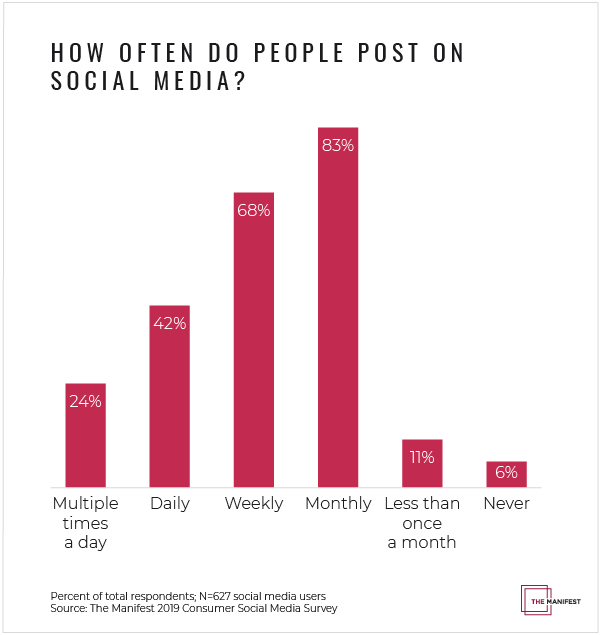
People post on social media to create a community with others, explained Joseph Rothstein, account manager at digital marketing agency Social Media 55.
“The average person living in a suburb could live on a little street with very little exposure to the outside world but have a community of thousands of people on social media who are engaged with their posts,” Rothstein said. “The more you post and the more quality posts you make, the more engagement you get. It makes people feel special and brings happiness to them.”
Posting on social media gives people a bigger community than if they never interacted on social media.
Avid hiker Cameron Abdo became a social media influencer by simply posting hiking pictures to his Instagram profile, @socaltravels.
“After a year or so of going on my own hikes and posting them on my Instagram, people started following,” Abdo said. “I woke up one morning, and there were 1,000 new people following my account because they were searching for new places to hike and explore. They see a beautiful image or a video of an outdoor space, and they want to go check it out as well.”
Abdo began to use his Instagram for more than posting pictures of hikes once he had a steady follower base. He now has almost 25,000 followers and uses the platform to inspire hikers to help conserve the environment.
“I realized that through social media, I could actually positively impact the environment around me,” Abdo said “At the end of the day, through building a community, you can get people not only passionate about going out into nature, but you can also inspire them to bring a trash bag and pick up the trash they see on the trail.”
Abdo consistently posts on Instagram about both hiking and conservation. Regularly posting and interacting on social media has helped him, and other influencers, build a community.
Businesses should use these influencers as an example and frequently post content on social media, too, to grow their follower base and engage customers.
Images Are the Most Popular Social Media Content for People to Post
People tend to post a variety of content on social media, but images are the most common.
More than two-thirds of people (69%) post images on social media.
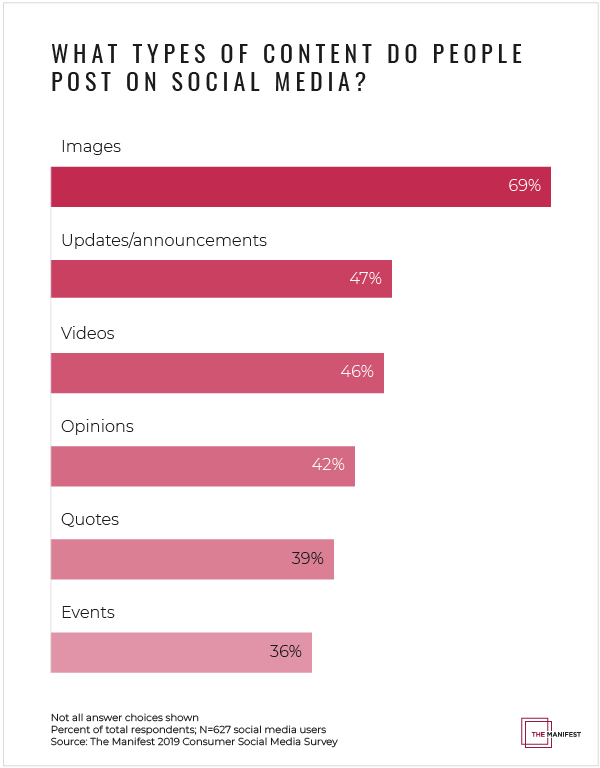
Technology has made it easy for people to share photos.
“Taking images is fairly easy, and a picture is worth a thousand words,” Chipperfield said. “Images make it easy to capture a feeling, an emotion, or something that’s entertaining.”
Images are more engaging than other types of content.
For example, photographer Pedro Kin found success on social media with his photographs of landscapes from around the world.
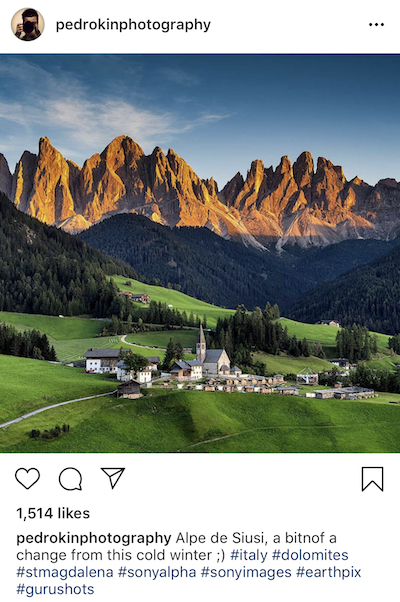
Kin has around 35,000 followers on his Instagram account, @pedrokinphotography. He found that images help his brand stand out on social media.
“Nowadays, people are in a very fast-paced environment [and] want to consume the most amount of information as quickly as possible, so photography can help that,” Kin said. “Not many people will stop and read a post.”
Social media users prefer to consume images, so people who post mainly images on social media tend to find the most success.
Businesses, too, should regularly post images rather than written text, as these posts will engage potential customers the most.
Facebook Is Still King
Although Facebook’s popularity is declining, it is still the most-used channel.
More than half of people (52%) use Facebook the most frequently – more than three times the number of people who most frequently use YouTube (16%) and Instagram (14%).
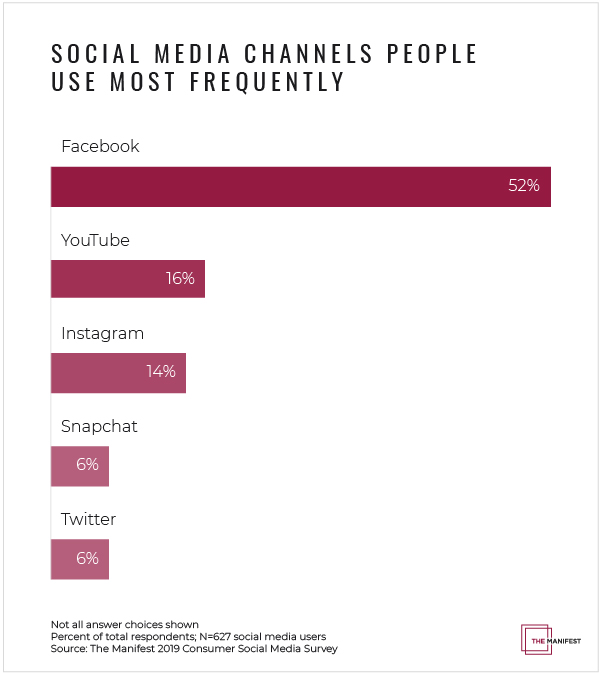
People access Facebook more frequently than other channels, but that doesn’t mean they spend the most time on that channel.
“Even if people are still clicking on the app or going to Facebook.com on their browser the most, the amount of time they spend on the platform has decreased,” said Andrew Selepak, graduate director of the social media department at the University of Florida. “If I watch a 20-minute YouTube video, I’m probably not spending a 20-minute block on Facebook.”
People likely spend more time on other channels than on Facebook, including YouTube and Instagram, two channels whose usage is growing at a faster rate than Facebook.
For example, filmmaker Jordan Taylor Wright, founder of Taylor Cut Films, uses Instagram the most.
“I use it as an outlet to express my art and how I’m feeling and to share the way I see the world,” Wright said.
On Instagram and other social media channels, Wright shares his real personality, rather than simply posting about his work, which includes videos for Usher, Ciara, and Justin Bieber and video campaigns for Tiffany & Co. and Audi.
Wright views Instagram as the best outlet for showcasing his personality, as opposed to his professional life.
“For me, that’s the strongest reason to use social media – to truthfully convey how you feel and how you see the world so others can see it from your own lens and vantage point,” Wright said.
Wright has a Facebook page with 35,000 followers, but his Instagram account, @taylorcutfilms, has more than 550,000 followers, which he has built with images and videos that show off his personality.
Many people like Wright use Facebook but focus more time and effort on other channels such as Instagram and YouTube.
Businesses shouldn’t forget the power of Facebook but should focus efforts on other channels, too.
People Most Often Use Facebook to Post Content
People are most likely to use Facebook to post and like content.
More than half of social media users are most likely to use Facebook both to share their own content (52%) and like someone else’s content (54%).
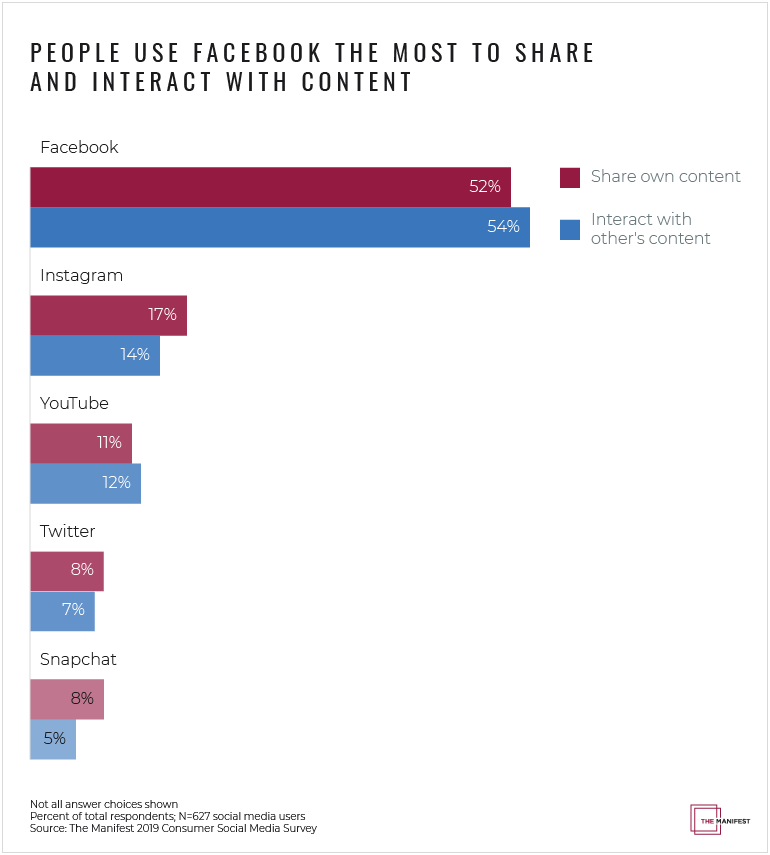
People find Facebook’s content more reliable than other channels’ content, according to experts.
“The Facebook algorithm is designed to curate a custom experience based on your interactions and participation,” Chipperfield said. “This creates a space where you know the content within your newsfeed is of high interest and value to you personally, which creates a comfortable space for sharing.”
Facebook is likely the most trustworthy channel because it is older and has a bigger user base than other popular channels.
People feel like the content on Facebook is valuable.
For example, health and lifestyle coach Lisa Lewtan regularly posts inspirational content on her Facebook page, which has more than 12,000 followers.
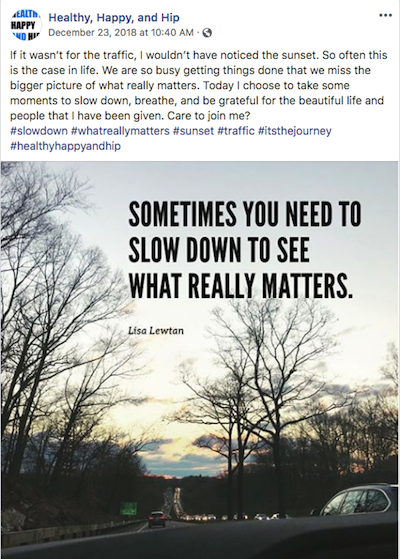
Lewtan has the most social media success with Facebook.
“I find that most of my peers are on Facebook, and it is a great place to build communities,” Lewtan said. “I feel that in the groups I run, I have a real sense of community that I haven’t been able to create in other platforms. Facebook is my constant.”
Facebook helps people like Lewtan interact with the highest number of people and build a community.
Businesses, too, should post often on Facebook, where people are most likely to interact with their content.
People Are More Likely to Interact With Someone Else’s Content Than Share Their Own
People tend to interact with other people’s content more often than posting their own.
Nearly half of social media users (48%) are more likely to share/like someone else’s content, including 30% who are much more likely.
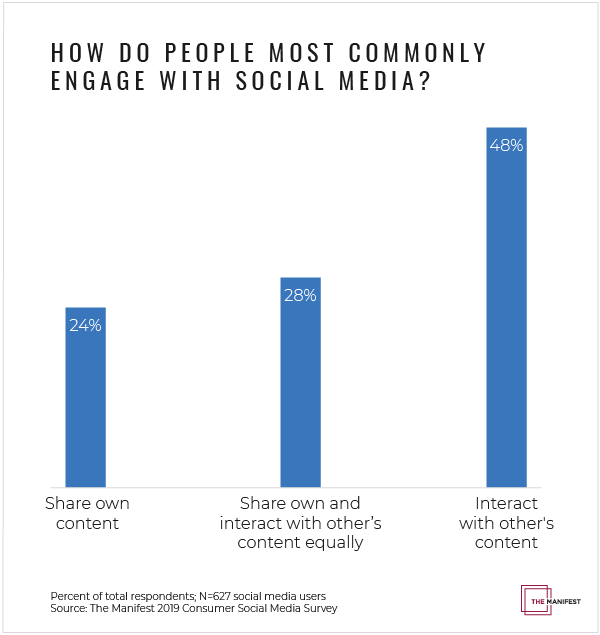
Just 24% of people are more likely to share their own content, including 14% who are much more likely.
It’s easier for people to share and like someone’s else content than consistently create their own.
“It’s hard to come up with an original idea 10 times a day,” said Josh Loewen, digital marketing director of The Status Bureau, a digital marketing agency in Vancouver. “The quotes and interesting things that exist on social media take zero thought to retweet or share.”
People also tend to go to social media more times than they actually post content; experts call this the “90-9-1 rule.” This rule states that 90% of the time, people are likely just consuming content; 9% of the time, people are interacting with content; and only 1% of the time, people are sharing content.
“Part of it is simple content creation,” Selepak said. “If you connect with 1,000 people on Facebook, that’s 1,000 people who could be posting. You’re probably not posting 365 days a year on Facebook, but at least some of your 1,000 friends are.”
People may interact with other's content more because it can generate positive connections.
For example, online marketer Stacy Caprio found a group of friends on social media who meet up once a month. A woman in the group influenced Caprio to move into her apartment building in Chicago.
“This woman inspired me to move into her building, due to her gorgeous Instagram and Facebook Live videos, where she showcased her beautiful apartment and its stunning views,” Caprio said. “It’s wonderful to now have an actual physical friend in my building and a group of women I get to connect with in-person monthly, all of which came out of a Facebook group connection.”
If Caprio didn’t interact with the woman’s social media posts, she never would have found her current residence.
People value interacting with other people’s content on social media.
Social Media Helps People Create a Community
Social media is an important part of people’s lives and gives them the ability to build a community of other like-minded people.
People interact on social media several times per day, and nearly every social media user posts content in addition to interacting with others. This gives people the ability to connect with others who have similar likes and interests.
Facebook is the most-used channel, though its popularity may be declining as people spend more time on other channels such as Instagram and YouTube.
As people use social media more often, it’s important for businesses to learn their customers’ habits so they can appeal to them where they spend much of their time – whether it’s Facebook, YouTube, Instagram, Twitter, or another social media channel.
About the Survey
The Manifest surveyed 627 people from across the U.S. who have used social media in the past week.
Sixty-five percent (65%) of survey respondents are female; 35% are male.
About 14% of respondents are Generation Z (ages 13-17), 36% are millennials (ages 18-34), 31% are Generation X (ages 35-54), and 19% are baby boomers or older (ages 55+).
Most survey respondents are employed either full-time (42%) or part-time (16%). Others are homemakers (13%), retired (13%), students (12%), self-employed (5%), unemployed and currently looking for work (6%), or unemployed and not currently looking for work (6%).
Survey respondents’ education levels are 8th grade or lower (3%), some high school (14%), high school graduate or equivalent (24%), some college credit, no degree (26%), associate’s degree (13%), bachelor’s degree (21%), and master’s degree or higher (12%).
Respondents are from the South (39%), Midwest (23%), Northeast (20%), and West (17%).

